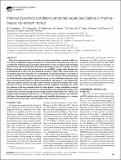Internal dynamics condition centennial-scale oscillations in marinebased ice-stream retreat
Abstract
Rates of ice-stream retreat over decades can be determined from repeated satellite surveys and over millennia by paleoenvironmental reconstructions. Centennial time scales are an important temporal gap in geological observations of value in process understanding and evaluation of numerical models. We address this temporal gap by developing a 3 ka and 123 km retreat time series for the Irish Sea ice stream (ISIS), a major outlet draining the last British-Irish ice sheet. The Llŷn Peninsula (northwest Wales, UK) contains numerous ice-marginal indicators from which we reconstructed a robust chronological framework of margin oscillations. The landscape documents the retreat of a former marine-terminating ice stream through a topographic constriction, across a reverse bed slope, and across variations in calving margin width. New dating constraints for this sequence were integrated in a Bayesian sequence model to develop a high-resolution ice-retreat chronology. Our results show that retreat of the ISIS during the period 24-20 ka displayed centennial-scale oscillatory behavior of the margin despite relatively stable climatic, oceanic, and relative sea-level forcing mechanisms. Faster retreat rates coincided with greater axial trough depths as the ice passed over a reverse bed slope and the calving margin widened (from 65 to 139 km). The geological observations presented here over a 123-km-long ice-retreat sequence are consistent with theory that marine-based ice can be inherently unstable when passing over a reverse bed slope, but also that wider calving margins lead to much faster ice retreat.
Citation
Smedley , R K , Chiverrell , R C , Ballantyne , C K , Burke , M J , Clark , C D , Duller , G A T , Fabel , D , McCarroll , D , Scourse , J D , Small , D & Thomas , G S P 2017 , ' Internal dynamics condition centennial-scale oscillations in marinebased ice-stream retreat ' , Geology , vol. 45 , no. 9 , pp. 787-790 . https://doi.org/10.1130/G38991.1
Publication
Geology
Status
Peer reviewed
ISSN
0091-7613Type
Journal article
Description
This paper was supported by a Natural Environment Research Council consortium grant (BRITICECHRONO NE/J008672/1).Collections
Items in the St Andrews Research Repository are protected by copyright, with all rights reserved, unless otherwise indicated.

